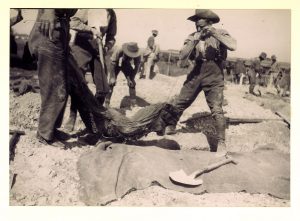‘What did you do after the war? The Missing is brief but packs a punch’, Honest History, 14 January 2020
Late last year (29 November), Melbourne’s Shrine of Remembrance saw the launch of The Missing, a brief (11 minutes) documentary about the Great War and its aftermath. The film, produced by Wind & Sky Productions (Lucinda Horrocks and Jary Nemo, with Fred Cahir as executive producer) describes the work of the Australian Red Cross Wounded and Missing Enquiry Bureau and (after the war) the Australian Graves Detachment and Graves Services. It can be found here on You Tube or obtained for showing.
The Missing was commissioned by the Victorian Government, with the involvement of Federation University, Ballarat, and many other institutions and individuals, notably the Red Cross and RSL Ballarat. The on-screen commentary comes from historians Bart Ziino and Melanie Oppenheimer, commencing with Ziino’s powerful introduction (the Great War as ‘an unprecedented encounter with mass death’). We hear about the destructive effects of ordnance, the ease of losing bodies, the ‘thousands upon thousands’ of the missing, the hopes held out by families far away that their soldier might still come marching home again. Oppenheimer talks of mass mourning at home, and Ziino pans the ill-conceived word ‘closure’, as a descriptor of what families sought or felt.
 Burial parties and relocating to proper graves, France, circa 1919. (Marcel Pillon photograph collection, ANZAC House, Melbourne)
Burial parties and relocating to proper graves, France, circa 1919. (Marcel Pillon photograph collection, ANZAC House, Melbourne)
The film describes the processes developed by the various agencies to find the missing, alive or dead. Stirling performers in the work were led by Vera Deakin, daughter of Alfred, but also included the anonymous but strongly constituted members of the post-war recovery detachments. Their occasional breakouts into alcohol consumption and other compensations were understandable.
Following the emphasis in recent years on what Australians in uniform did in the war, this documentary is refreshing in its emphasis on the behind-the-scenes work during the conflict and particularly on the harrowing task of finding, identifying – and relocating – bodies after the Armistice. One ventures to suggest that, at the time, the fate of missing soldiers would have been of greater interest to their families than accounts of their exploits under fire, but that balance has shifted greatly over the decades since World War I.
While the Australian War Memorial supplied some of the footage used in the film, the Memorial’s own coverage (in its World War I galleries) of the aftermath of the Great War is pretty sparse; The Missing helps to redress the balance. (The Memorial’s After the War exhibition dealt with the aftermath of all our wars, perhaps because of the Memorial’s relative lack of holdings – and lack of interest – on what happened after any one conflict.) Something similar for World War II would be well worth doing. The Missing is recommended.
* David Stephens is editor of the Honest History website.


1919
Perhaps the AWM should at least have this production playing in the WWI section. One note on the photo … “circa 191???”